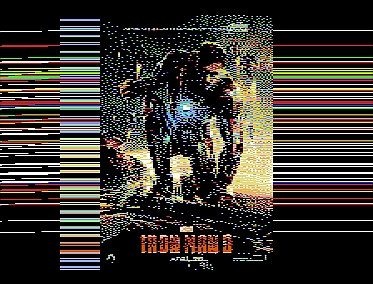Winner get's a preview

Moderator: Moderators

No need to be sorry. The FLI96-mode needed some more 'splaininWilson wrote:Sorry for forcing you to explain all that. I probably should've just gone back and read/re-read the past parts.
YES! Exactly! Very niceAre you using the column expansion to reveal new characters as a method to get unique colors below red A,B,C without touching their color memory?
Good questionHow does the VIC know what screen position it's at when you change the values of $9002 as it's drawing? Does it check at lines with the tops of the characters?
Actually the "penalty" is only 2 LDA/STA, since the $9002 updates are necessary anyways to switch the color-RAM betwenn $9400 and $9600. It's an added bonus that I need to change the line width as well and can do this in one write to $9002.Must be more to it than that though if it takes 4 LDA#/STA's to do the $9000/$9002 updates versus the 3 you save.
In total they get drawn 4 times, twice of those within the eight-line-block (line 5 and line 7) and twice pre-set in the VBLANK-area or the small area between line line 7 and the next line 0. So I save 6 character updates instead of just 3 per eight-line-display-block. So this means in an eight-line-block I update 4 x 13 chars plus 2 x 10 chars = 72 chars the same number als in FLI96. However this means in order to get 13 characters per line in an eight-line-block I need to update the other 32 chars (of a total 13 x 8 = 104) per eight-line-block in the VBLANK or the "in between"-areas of each such block. You can see in the diagram above I have time for updates in Line4 for position D,E and F in this small area, leaving 32 x 29 = 928 characters to be updated during VBLANK.Would this mean D,E, and F get drawn twice?
Ohhh, of course.Actually the "penalty" is only 2 LDA/STA, since the $9002 updates are necessary anyways to switch the color-RAM betwenn $9400 and $9600. It's an added bonus that I need to change the line width as well and can do this in one write to $9002.
Now THAT sounds like a problem. Can you elaborate on what you mean by update? In that amount of time I can't think of anything but some zeropage STA/STX/STY, PHA's, and absolute STA/STX/STY's with a few LDA#,LDX#, and LDY#'s.Now if you can guess how to update 928 characters in 56 x 71 = 3976 cycles you win this little quest Smile
With update I mean a change back of a byte in color-RAM to it's "initial" value. Specifically line 0 and 2 of each eight-line-block need to be updated in the VBLANK since they are destroyed during the display of each eight-line-block. So these are writes to $9400,$9401,... and $9600,$9601,... (not stack or zeropage)Wilson wrote:Now THAT sounds like a problem. Can you elaborate on what you mean by update?Now if you can guess how to update 928 characters in 56 x 71 = 3976 cycles you win this little quest Smile
I'm not really sure how you came up with those numbers, but...I guess that works out to 1536 cycles for writing the zeropage and stack, 1664 for everything else, which leaves (3976)-(1536+1664)=776 for LDA#,LDX#,and LDY#'s. Or 388 immediate loads.
This is essentially it. There are only 16 possible values in color-RAM (8 for each color and the multicolor-bit can be set for each of those). So I only need 16 LDAs from lda #$00 to lda #$0f, and after each of those I need to STA the value to each color-RAM address that is going to have this value in line 0 and 2 of each of the 32 eight-line-blocks in the picture. Giving a total of 928 x 4 (STA) + 16 *2 (LDA#) = 3744 cycles. Leaving 232 cycles free, a few of which are used by the rotuine that waits for a keypress to exit the viewer. Also I need two switches for $9005 after half a picture each, since I use two video-RAMs at $0000 and $0200 and a full 4K char-RAM at $1000-$1fff and this only works with a switch of $9005 in the middle.If you use each value multiple times before reloading it, that should be sufficient for updating all the locations with arbitrary values.
